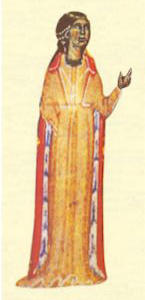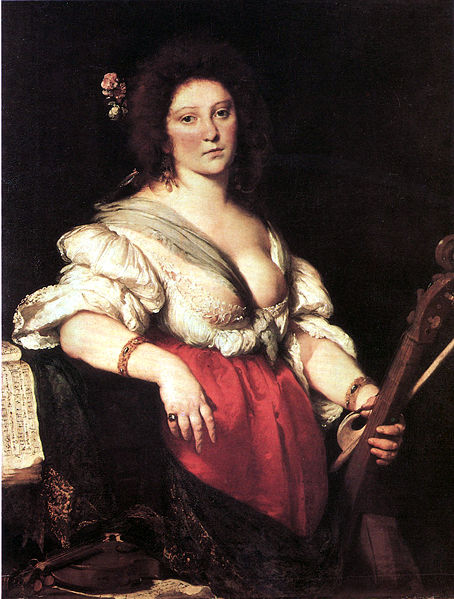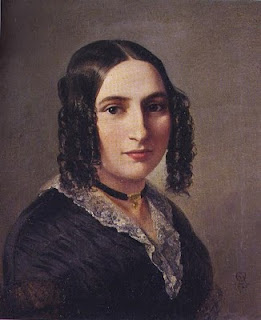Classical music — at least in the United States — is one of those areas that tend to be something of a hole in a lot of people’s education. I’ve been continually surprised by the number of extremely intelligent people I know who can discuss politics, visual art, film, philosophy and popular music in detail who, nevertheless, don’t know very much about classical music – at least, beyond the three B’s (Bach, Beethoven and Brahms) and Mozart. Maybe Haydn or Handel. Maybe Wagner (but usually only Ride of the Valkyries). Maybe a 20th-century composer or two like Stravinsky or Copland. But certainly, never about any of the women over the years who have written classical music. After all, just about every field of art tends to diminish the accomplishments of women, but especially classical music, since most of it that outsiders pay attention to was made in a time when women’s roles in the arts were limited. Even today — in an era where there are countless amazing female composers — when I tell people I studied music composition in college, I still get “Wow, a woman writing classical music! I’ve never heard of that!” about as often as I get, “Wait, people still write classical music?”
But women have always been writing classical music; it’s just that, now, we’re more able to make a career of it, and compete with the guys. In the past, women were often limited in what they could write, thanks to gender roles. The rules for a female composer of the 18th or 19th century (when most of the best-known male composers flourished) were: only solo and small-ensemble works that you could play in your living room (which is why we now know this as “chamber music”). Never large-scale works, like operas or symphonies, where you would need to rent out a concert hall to have them properly performed. It’s easy to see how this was able to limit women; while there are a number of male composers known primarily for their chamber music (such as Chopin), most of them, while they wrote in a variety of genres, made their names through the big stuff. In fact, some of the biggest, most influential composers of that era were known mainly for writing operas, like Verdi and Wagner, or symphonies, like Gustav Mahler. Even the men who became famous for their chamber music were usually able to get them performed in large halls, unlike women, who were limited precisely so they wouldn’t be taking attention — and careers — away from men.
However, women were making headway in what would become classical music long before these rules came into place. And even once they did, women found ways to get their voices heard despite the odds.
The Early Years
Music, unlike the visual arts, is one where we don’t have as many records from the ancient world as we would like. There are plenty of ancient Greek musical treatises — which helped set the foundation for modern Western music theory — but not a lot in the way of actual music for anthropologists to check out, and most of that does exist is only in fragments. The oldest known complete musical composition in the world only dates to about 200 B.C.E.-100 C.E. As such, the history of Western music doesn’t really get rolling until the Middle Ages — and one of the most dominant musical figures of that era was a woman, the German abbess St. Hildegard von Bingen (1098-1176 C.E.).

Hildegard von Bingen….how do I even begin to describe Hildegard von Bingen? I could start by saying that she’d be a worthy competitor of Eleanor of Aquitaine or Joan of Arc for the title of “most kickass medieval woman,” despite not being nearly as well-known today. Her accomplishments went far beyond just music (in fact, the class where I learned the most about her wasn’t even a music class). She was a prolific writer, on such subjects as “recorded visions, medical and scientific treatises, hagiography and letters; also lyrical and dramatic poetry, which has survived with…music,” according to The Norton Grove Dictionary of Women Composers. Heck, she even invented her own alphabet, and her medical texts are still influential today with advocates of natural remedies. Her mystical visions, which she’d seen since childhood, earned her quite an audience, with people ranging from popes to monarchs seeking her for guidance on matters from theology to politics and diplomacy. In an era when most people — much less, women — never left their home villages, Hildegard went on four preaching tours throughout Germany (at the time, mostly part of the Holy Roman Empire). She used her platform not just to spread her theological views and tales of her visions, but also to call for reform within the church.
As far as music goes, St. Hildegard used her visions to write some truly gorgeous liturgical music. She set her own lyric poetry to music, collecting it in the Symphonia armonie celestium revelationum in the early 1150s, as well as writing music based on more typical hymn texts. One of her best-known works is the Ordo Virtutum, a morality play which is the only one from the medieval period where both the text and the music survives. It portrays a group of Virtues and Satan battling for a soul, or anima. The work calls for 17 female soloists (portraying the “Virtues” and the anima), male and female choruses and a male voice (portraying Satan) that only speaks, doesn’t sing, because according to Hildegard, the Devil should not be able to product “divine harmony.” You can watch a portion of a performance here:
[youtube https://www.youtube.com/watch?v=gLpgj0s8o8s&version=3&hl=en_US]
And yes, St. Hildegard might have even had a queer side. She had a close relationship with a fellow nun, Richardis von Stade, which some scholars believe may have been romantic in nature. When Richardis was appointed abbess elsewhere, Hildegard wrote letters urging that the decision be reversed, to no avail, only for Richardis to die shortly after her departure. Some believe the “anima” in Ordo Virtutum may represent Richardis, and her dying request (to her brother) is to return to Hildegard, like how the repentant anima returns to God in the morality play. Some scholars also attest to a pattern of focus on the female body and female desire throughout Hildegard’s music.
Though she was nominated for it repeatedly, beginning only a few decades after her death, Hildegard has only just recently been officially canonized as a saint. But she also has an asteroid named after her, which is even cooler in my book.
[youtube https://www.youtube.com/watch?v=MhrL4wHkyRs&version=3&hl=en_US]
Later in the Middle Ages, during the 12th and 13th centuries C.E., we had the famous troubadours — traveling composers of (mostly) secular love songs in southern France. But did you know there were female troubadours, too? Known as trobairitz, we don’t know a lot about these women, since many of them were anonymous — and for the few whose names we do know, a lot of the biographical details have been lost. But what is interesting is that a number of their love songs were addressed to other women. Most of them still kept up the convention of having the song’s “narrator” be male, but there is at least one example — the song “Na Maria” by Bieris de Romans (embedded above) — where the singer and object are both suggested to be women. While it’s controversial — many see the lyrics as merely religious devotion toward the Virgin Mary — there are scholars who view “Na Maria” as an early example of “lesbian desire” expressed in Western music.

Several centuries later, Venice, Italy was the center of the music world, where new genres of vocal music developed during the late Renaissance and early baroque periods — the late 16th and 17th centuries. During this time, another notable woman composer came on to the scene: Barbara Strozzi (1619-1677).
Strozzi was lucky that, unlike most women, she was encouraged in her musical talents by her adopted father, Giulio Strozzi, a writer who was able to introduce her to Venice’s intellectual elite. She was trained and performed as a singer and studied with important composers of the day, such as Francesco Cavalli, one of the early Venetian composers of the then-new genre known as opera. She was one of the most prolific vocal music composers of her time, writing hundreds of music in both traditional genres like madrigals and motets, and in the new genre of the cantata, where she was a pioneer.

Cantata is Italian for “to be sung,” and the baroque-era version of the form consisted usually of works for solo voice, in sections of recitatives (sections with talk-like singing) and arias (expressive, lyrical sections). Later in the period, Bach became known for his choral cantatas, but Strozzi was one of the early composers in the form. Below is an excerpt from her cantata Lagrimie mie:
[youtube https://www.youtube.com/watch?v=w2lBnocuMC0&version=3&hl=en_US]
Giulio Strozzi’s proto-feminist sensibilities garnered Barbara an opportunity that would be closed to most women composers for centuries: getting published. She published eight collections of her vocal works between 1644 and 1664, seven of which survive. She likely sang a number of her works in academic meetings at her father’s music school, the Accademia degli Unisoni, and in private performances and social gatherings at the family home among various members of the Venetian high society. Renowned for both her poetry and her music, Strozzi was a woman ahead of her time — far ahead of her time, as it would still be several centuries before most women could have serious careers as composers.
“Shakespeare’s Sister” and the Women Composers of the 18th and 19th Centuries

Those of you who have read your Virginia Woolf will remember the story of “Judith Shakespeare,” a fictional, equally-talented sister of Shakespeare who Woolf mentions in A Room of One’s Own to show how it was impossible for a woman to have Shakespeare’s career and impact in his time. You can read the whole excerpt here, but suffice it to say that her point is that a woman with Shakespeare’s genius could never have achieved what he did because of her lack of access to the same opportunities, including education, and parental and social support for her ambitions.
What is interesting when looking at the history of women composers is there are at least two real-life examples of the “Shakespeare’s Sister” principle: Maria Anna Mozart (1751-1829) and Fanny Mendelssohn (1805-1847), sisters of the far more famous Wolfgang Amadeus Mozart and Felix Mendelssohn. Though they shared their brothers’ precocious talents and early training, beyond childhood they were limited by the restrictions placed on women during their time.
It’s well-known that Wolfgang Amadeus Mozart was playing and writing music from an early age, and had toured all over Europe before he was ten, thanks to his “stage parent”-like father, the composer Leopold Mozart. What’s less well-known is that young Mozart’s music lessons were inspired by the ones Leopold gave to older sister Maria Anna, nicknamed “Nannerl;” Wolfgang admired his sister’s brilliance at the keyboard and wanted to be like her. However, while Wolfgang continued to develop his career as an adult, becoming one of the most famous and influential composers of all time, Nannerl was forced to stop in 1769, when she reached “marriageable age.” Though some scholars think she could have been just as talented as her famous brother, we’ll never know, as none of her compositions survive.

There’s a somewhat more encouraging story with Fanny Mendelssohn Hensel. Both Fanny and Felix, like the Mozart kids, showed prodigious musical talent and were writing original compositions from an early age. However, while her brother was able to get public performances, Fanny’s music was limited to her own private salons. Her father wasn’t very supportive of her composing career, thinking a musical career inappropriate for a woman of her social class; her brother praised his sister’s abilities but only thought people would pay her pieces attention if he published them under his name, which he often did. However, Fanny’s husband, the painter Wilhelm Hensel, supported her, which is why her salons — where she presented her own works, which include over 250 songs and 125 piano pieces — were able to be as influential as they were. But her father and brother’s lack of support meant it was hard for Fanny to do much outside of the small private sphere. Most of her pieces were published after her death, when she started getting attention as a brilliant composer in her own right, not merely “Felix Mendelssohn’s sister.”
Among Fanny’s masterpieces are Das Jahr (1841), a group of piano pieces inspired by the twelve months of the year, and her Piano Trio, op. 11, the only one of her ensemble works published in the 19th century (in 1850, three years after her death). Below is a full recording of Das Jahr:
[youtube https://www.youtube.com/watch?v=hCy1CDrUtes&version=3&hl=en_US]
But Clara Schumann (1819-1896) was a woman in the 19th century who had a fairly illustrious career. While she’s better known now as the wife of composer Robert Schumann, during their lifetimes, Robert was the one known as “Clara Wieck’s husband.” Clara had an ambitious father, Friedrich Wieck who, like previously-mentioned musical parents, taught her piano from an early age and had her touring Europe beginning at age nine, making her one of the era’s most famous pianists and earning her the admiration of such big names in the Romantic-era piano world as Chopin and Liszt. Unlike Nannerl or Fanny, though, Clara had no brother to compete with her, and her father supported her continuing her career into adulthood. In fact, he might have watched over her a little too much; when she wanted to marry Robert, who was one of her father’s students and nine years Clara’s senior, he did everything in his power to prevent them from doing so, which resulted in a long legal battle that eventually ended with Clara and Robert prevailing. After marriage, Clara often found her desire for a career as a touring pianist and composer at odds with Robert’s lack of interest in touring himself, and his desire for a more traditional wife, but she didn’t let that stop her. In fact, she used her influence as a popular concert pianist to promote her husband’s compositions, and was also able to keep their finances afloat with her performing career when Robert’s mental and physical health began to deteriorate.
Clara composed a great deal from her youth into middle age, including larger scale works like a piano concerto, and would perform her own works in her public programs, earning her an audience inaccessible to most female composers of the time. She said, “Composing gives me great pleasure…there is nothing that surpasses the joy of creation, if only because through it one wins hours of self-forgetfulness, when one lives in a world of sound.” However, later in life, she began to lose confidence in her abilities, claiming “I once believed that I possessed creative talent, but I have given up this idea; a woman must not desire to compose — there has never yet been one able to do it. Should I expect to be the one?” But the growing modern audiences for her work would seem to disagree. You can judge for yourself here:
[youtube https://www.youtube.com/watch?v=CoTQq-3E90o&version=3&hl=en_US]
It’s also been speculated that Clara Schumann had a relationship with a certain famous B-composer whom Clara and Robert mentored, Johannes Brahms, though historical evidence doesn’t suggest anything more than Brahms having a very strong unrequited crush on her. (I mean, who wouldn’t?) But a lot of their letters were destroyed, which leads some to speculate that there must have been a reason for their destruction. Regardless, or perhaps because, of the lack of solid evidence, the Robert Schumann-Clara Schumann-Brahms love triangle is kind of a hot topic in classical music geek circles, leading to shipping debates of Team Edward vs. Team Jacob proportions.







